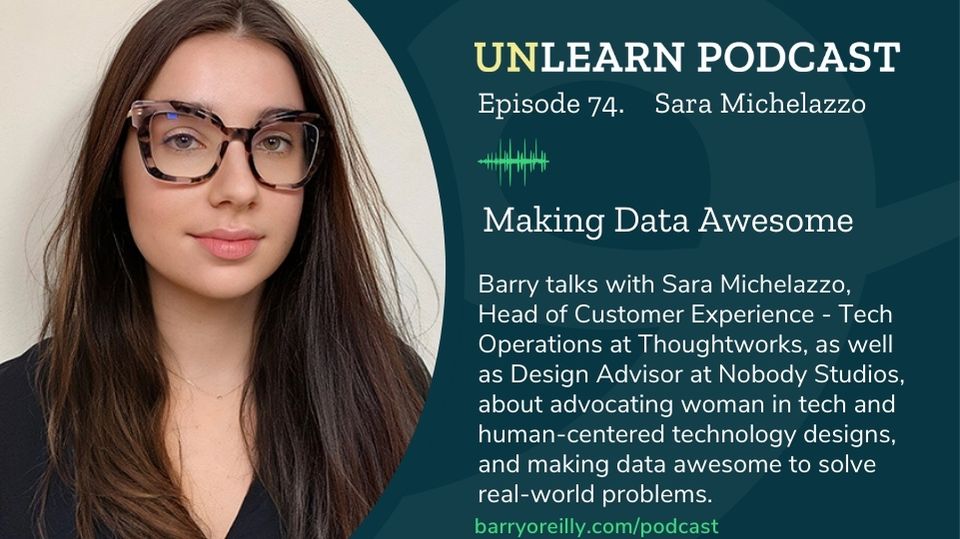Barry O’Reilly and Sara Michelazzo know each other from their days working together at Thoughtworks. Sara is Head of Customer Experience – Tech Operations at Thoughtworks, as well as Design Advisor at Nobody Studios. Sara is an advocate for women in tech, cryptos, and NFTs. In this week’s show, she and Barry discuss human-centered technology design, and making data awesome to empower users to solve real-world problems.
Empowering People with Technology
“I’ve never been a superfan of technology for technology’s sake, but more about all the opportunity that technology brings to empower people and allow them to do things that they couldn’t do before and connect them in new, meaningful ways,” Sara remarks. She tells Barry that it was seeing how technology allowed her father to continue working on his passion during his illness, that drove her to pivot from her art career into tech. It’s about empowering people, she emphasizes. “How do we empower people? That’s experience design. And then how do we empower teams to empower people with technology? And that is how I see leadership in technology.” [Listen from 2:10]

Human-Centered Design
Making technology simple for users is at the heart of human centered design. Sara tells Barry that she fully grasped the power of intuitive design through her father’s experience. Technology should be easy for users to grasp and adopt, she posits. We should design for 50% of people’s attention instead of 100%, because we all have so many other things going on in our lives at any moment. Barry asks her about the future of tech and what she had to unlearn regarding technology design. Humans are the same while technology is growing exponentially, she responds. As such, we need to meet people where they are and bridge the gap. “The human centered approach of approaching technology and making things accessible for people and understandable for different ranges of people – wherever is their background and their tech literacy – I think it’s going to become very, very important,” Sara says. [Listen from 4:45]
Making Data Awesome
Barry and Sara discuss Thoughtworks’ journey to become data-driven. The best software or spreadsheet means little if people don’t know how to use the data, they both agree. “The pursuit of business intelligence and dashboarding and data is one thing, but what you do with it is another,” Barry comments. Sara realized that her strength was in seeing the user’s perspective; she got comfortable asking questions such as, ‘Will the user understand this?’ and ‘How are they going to use it?’ She tells Barry, “I realized that a lot of design thinking and product strategy apply really well to technology but also to the data space, because at the end of the day it’s always [about] how we are empowering people and what they’re going to do with it.” [Listen from 9:00]
Shifting the mindset from data and dashboards to people was a tall order, Sara says, but it was the only way forward. People don’t care about data per se; they just want to do better work. This was the principle behind their Data Awesome framework – for users to experience data delight instead of data frustration. Data delight is “when the data experience exceeds expectation because the users feel empowered to complete what they have to do in a better way that they couldn’t do before,” Sara explains. The Data Awesome framework is made up of six simple steps including:
- Understand the audience;
- Define the job to be done;
- Determine the questions to answer to get the job done;
- Find the answers. [Listen from 14:45]
Defining the Data Journey
Thoughtworks’ dashboards are organized along a two-step data journey. Step one asks you if you have a problem; if the answer is no, then you don’t need to move further. If you answer yes, step two helps you identify the problem and then find solutions. Sara likens the data journey to a storytelling course she took, where the only question her teacher asked is ‘So what?’ She remarks, “You put the first piece of information and then, ‘So what? So what can you do with that? What is the next step?’ And then you add another piece of information and then, ‘So what?’ until you’re able to close the cycle and actually help people to get things done.” She describes the gratifying outcomes of teaching people to use the framework, in particular, how they would refer to the data journey as before and after the Data Awesome program. “When I started I was terrified because I was no data expert,” she tells Barry, “and I realized later that they had plenty of data experts. What they were lacking was some people that could bridge that gap between how humans can get empowered by technology.” [Listen from 19:55]
Looking Ahead
Barry asks Sara what she is looking forward to as she looks to the future. The opportunities that NFTs bring makes her excited. “I’m learning tons about unstructured people achieving incredible results, and it’s very refreshing to see how hundreds of people can contribute to an outcome without being in meetings or meeting each other very often,” she tells Barry. They talk about the value of the community of followers and creators. “The value of the NFTs goes up as the popularity of the project increases. The idea is that we’re all in this together,” Sara comments. [Listen from 33:05]















